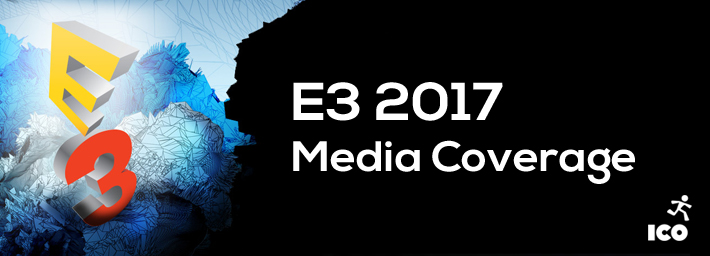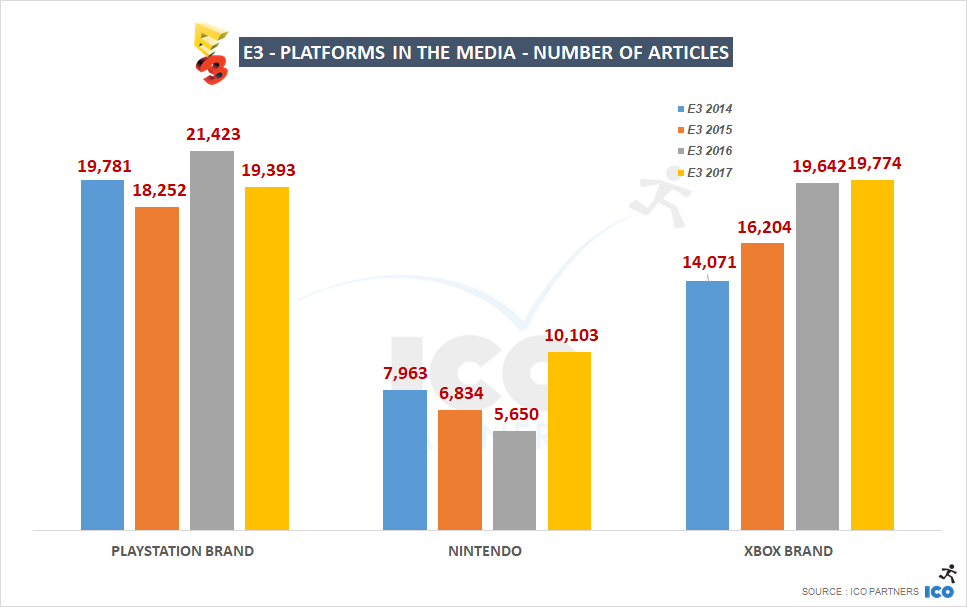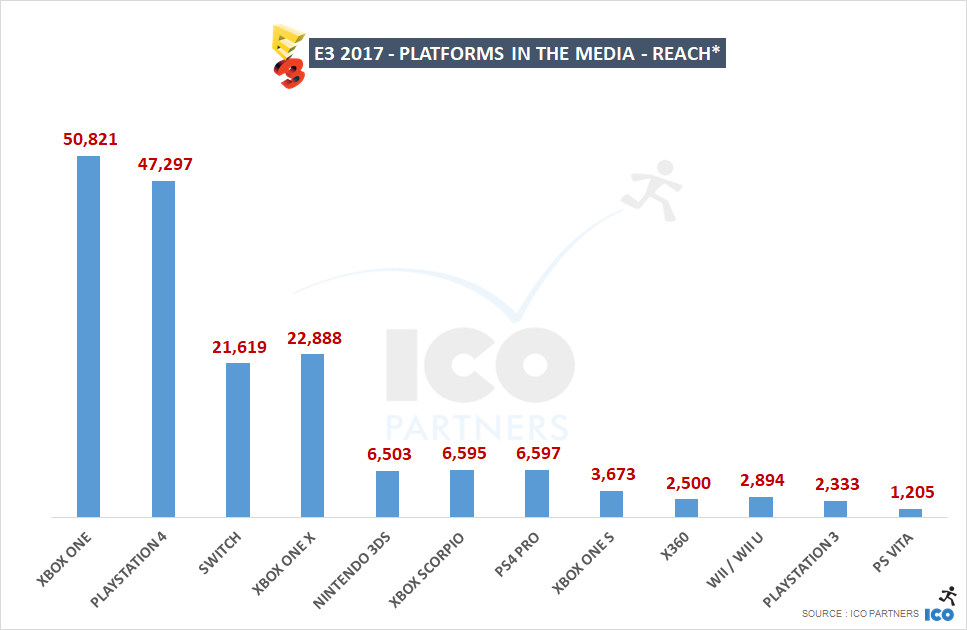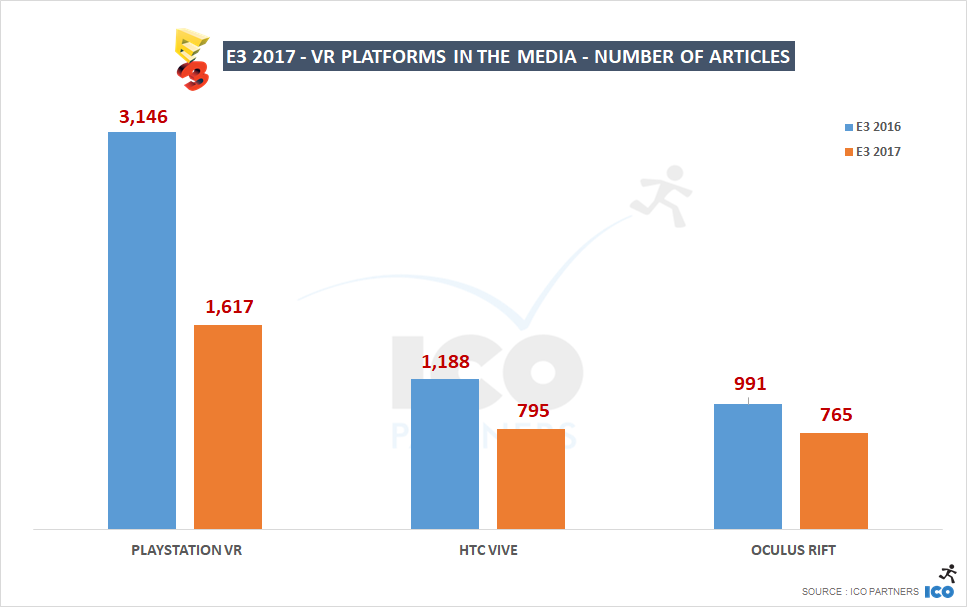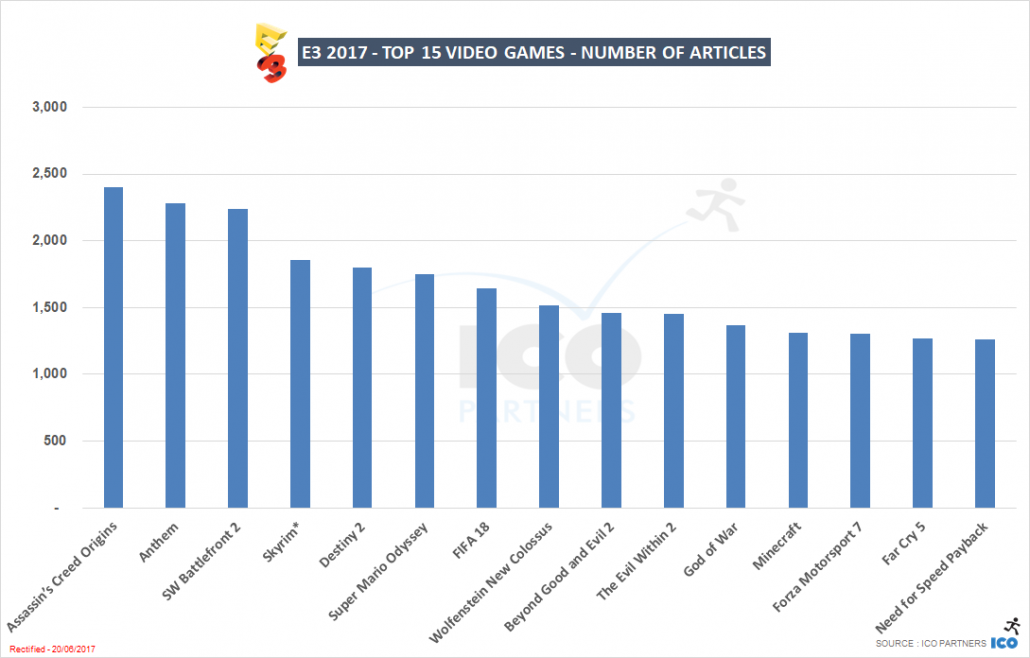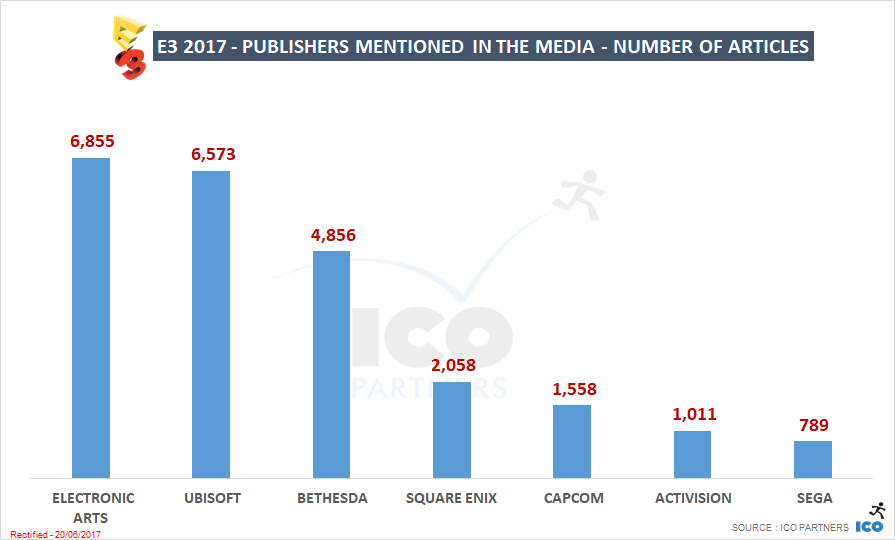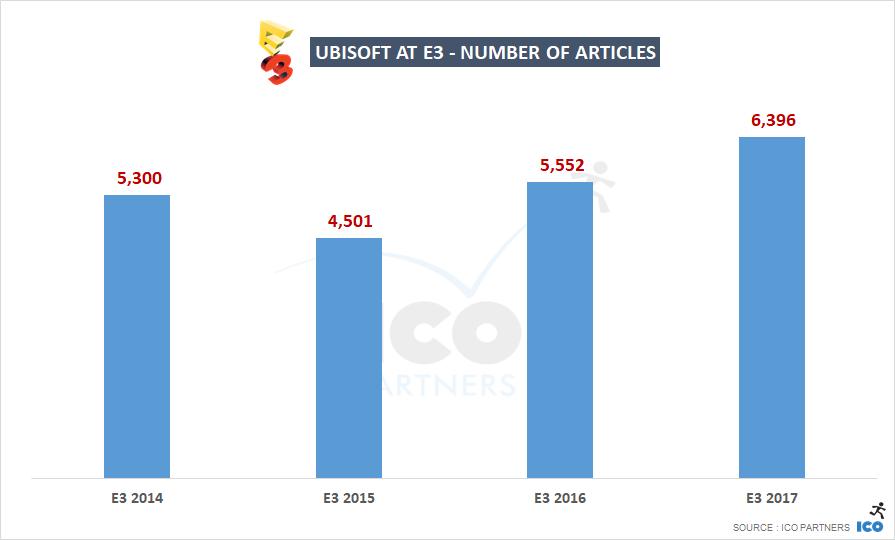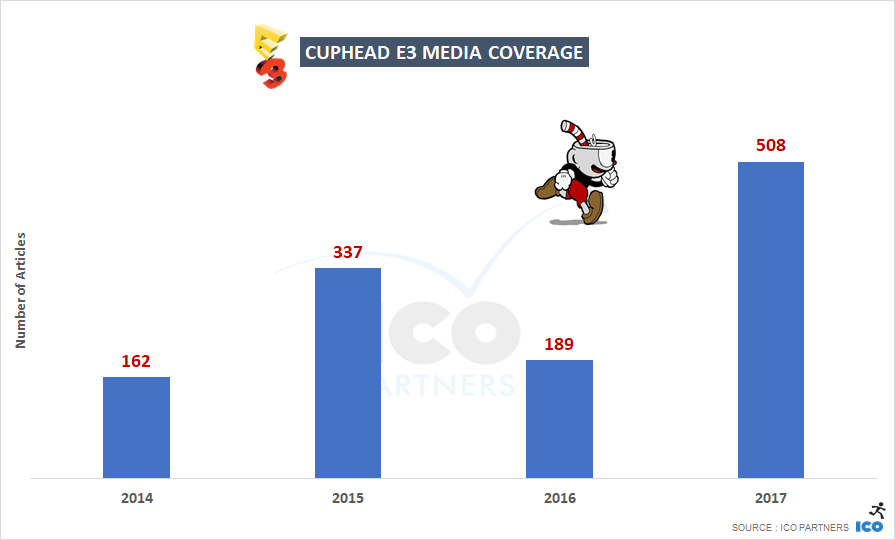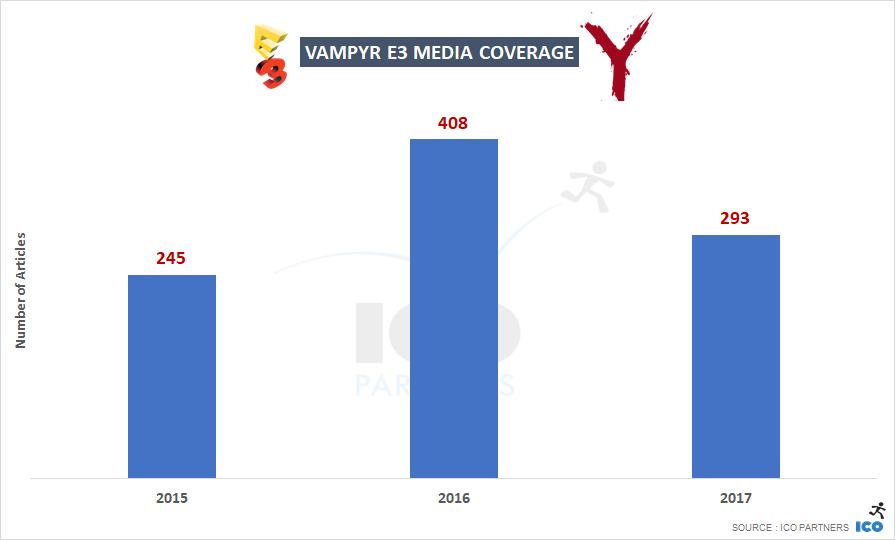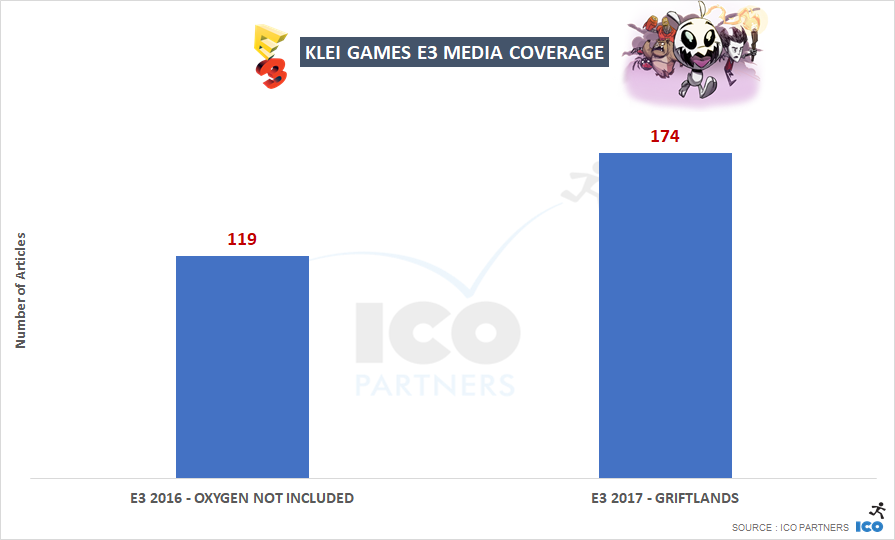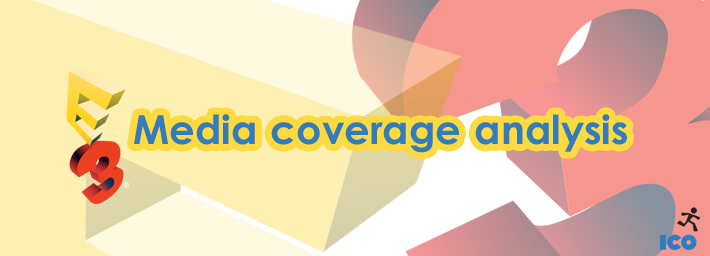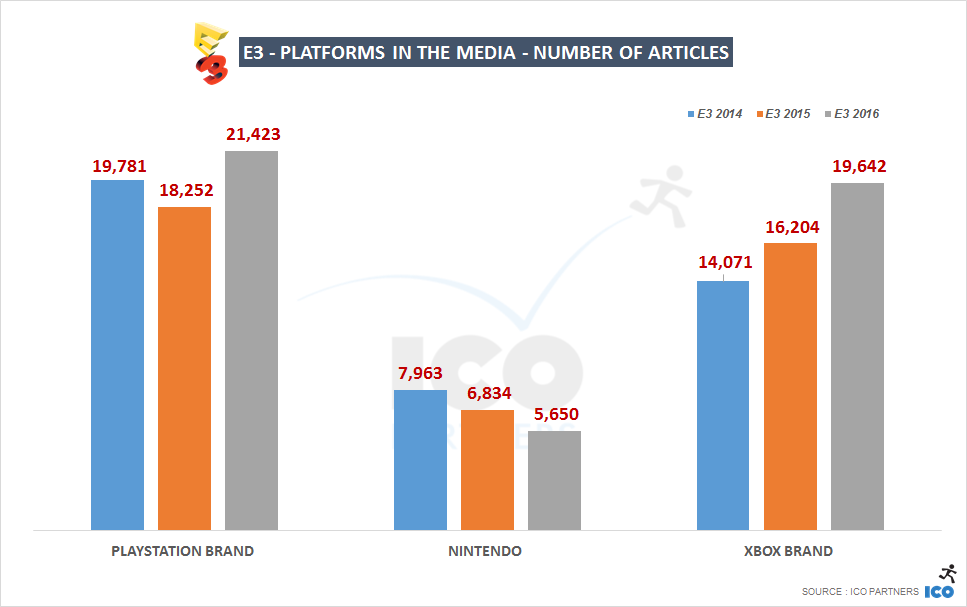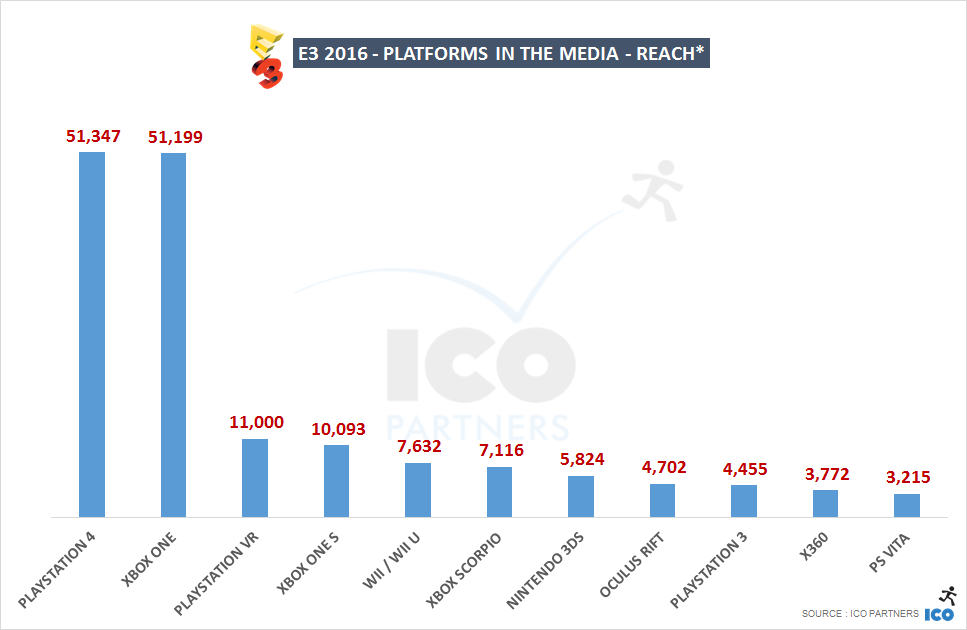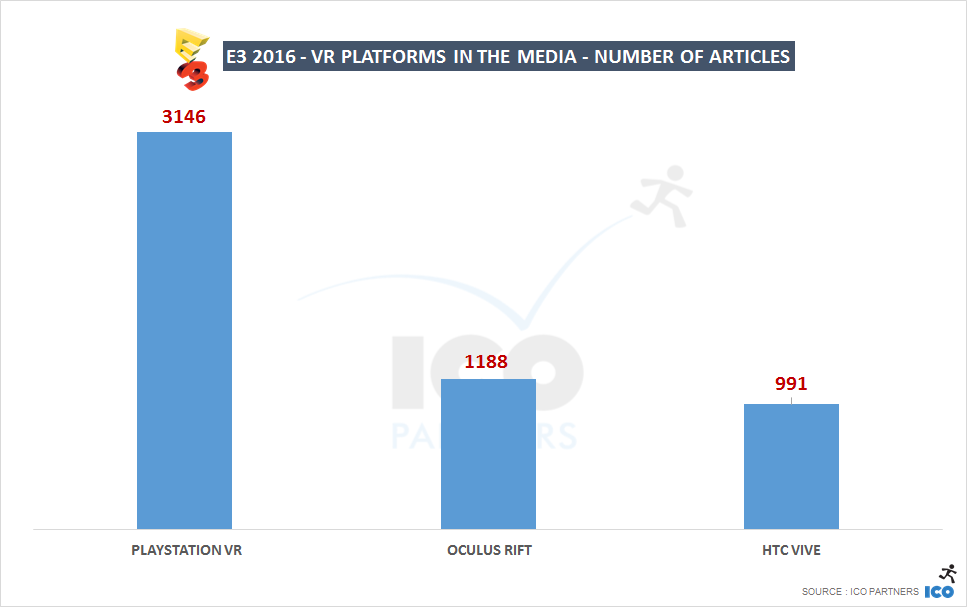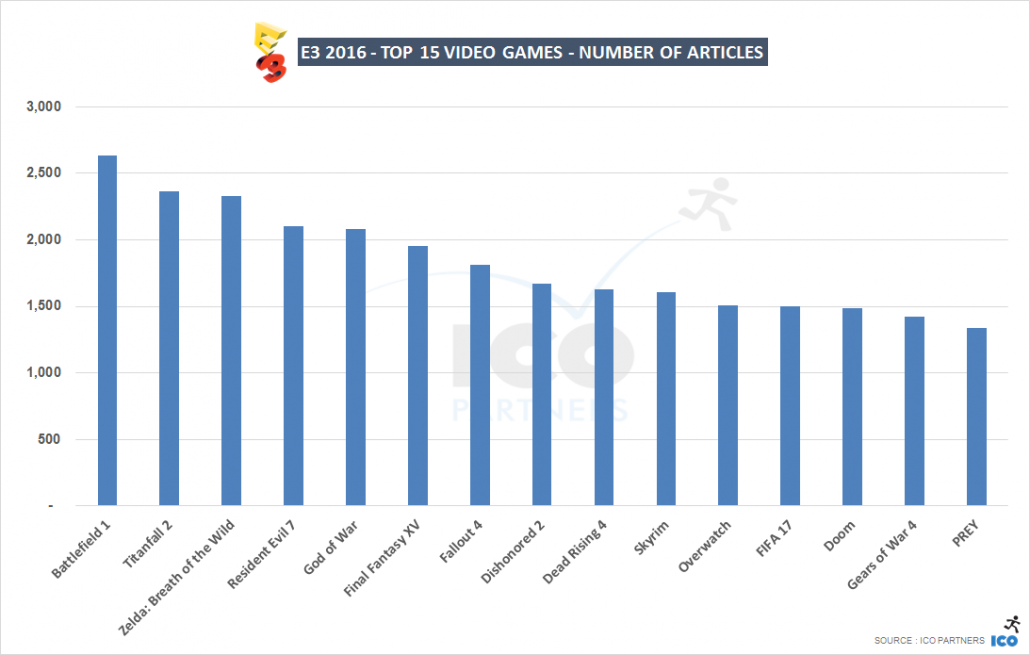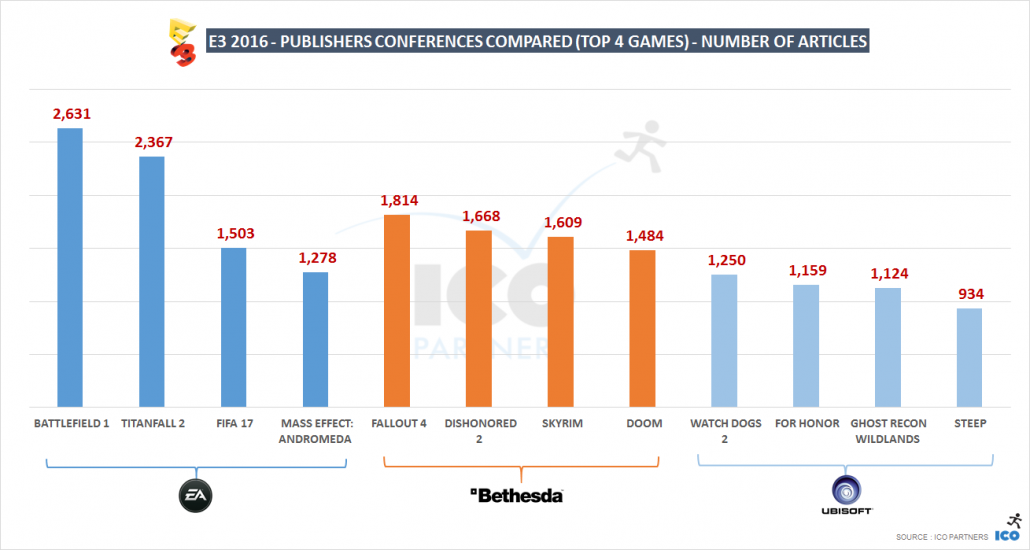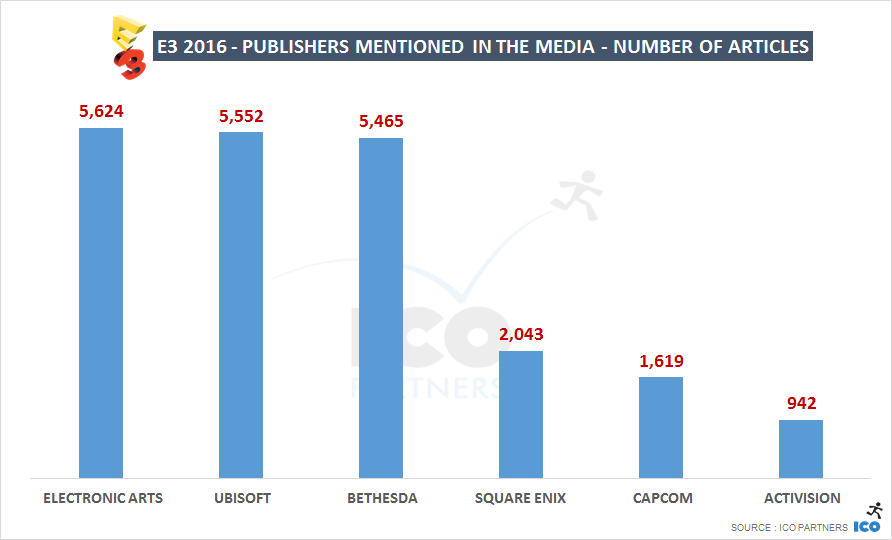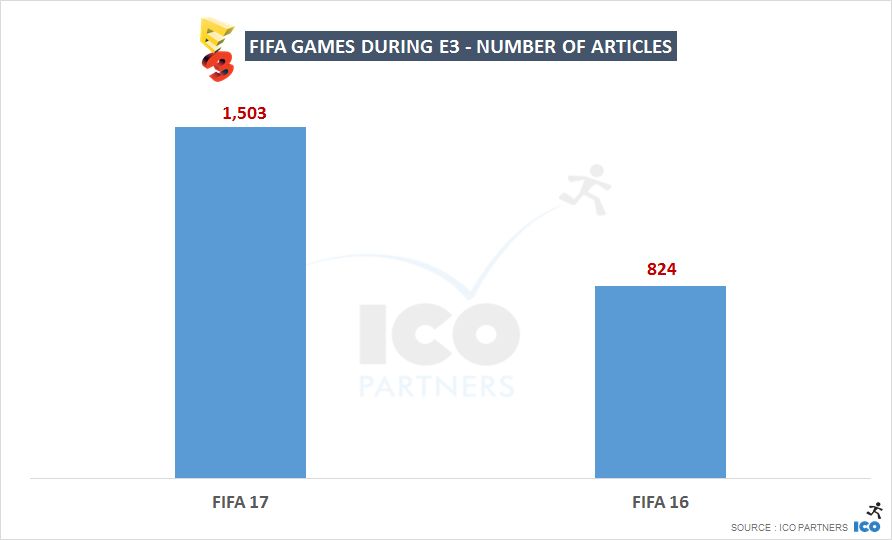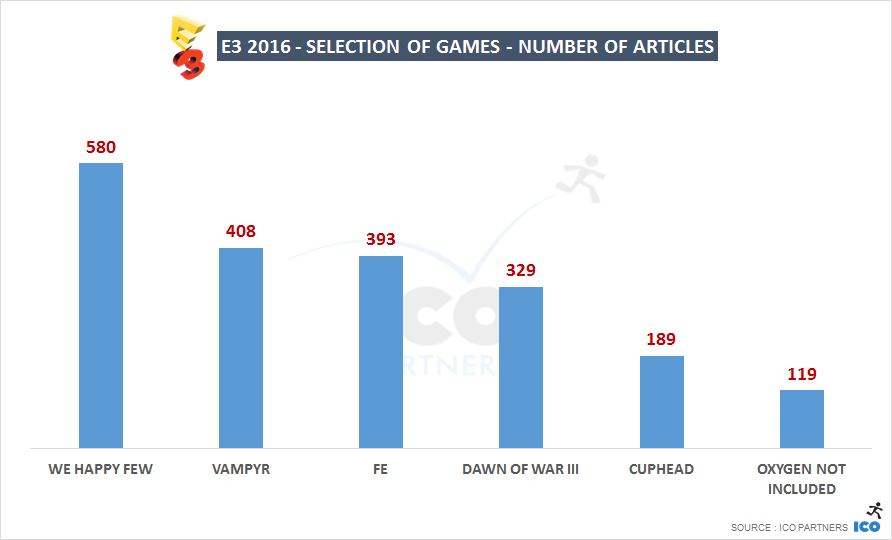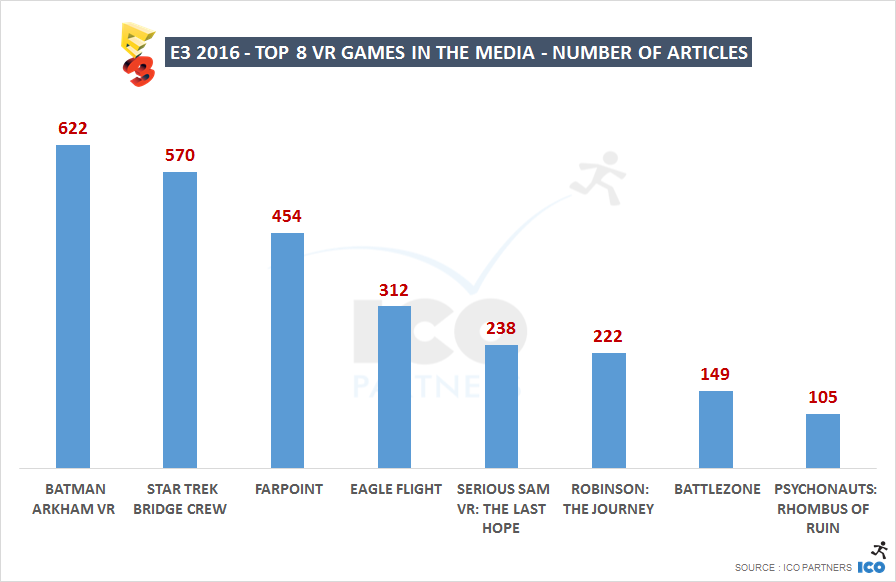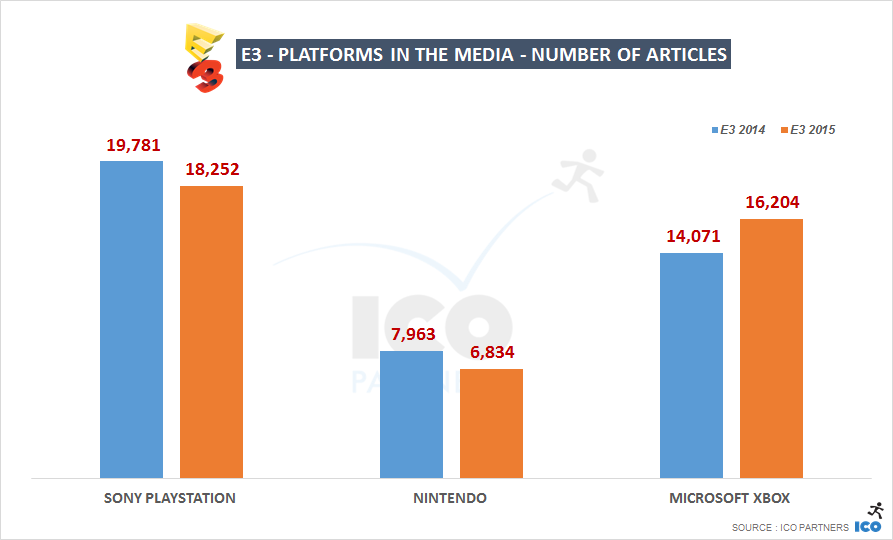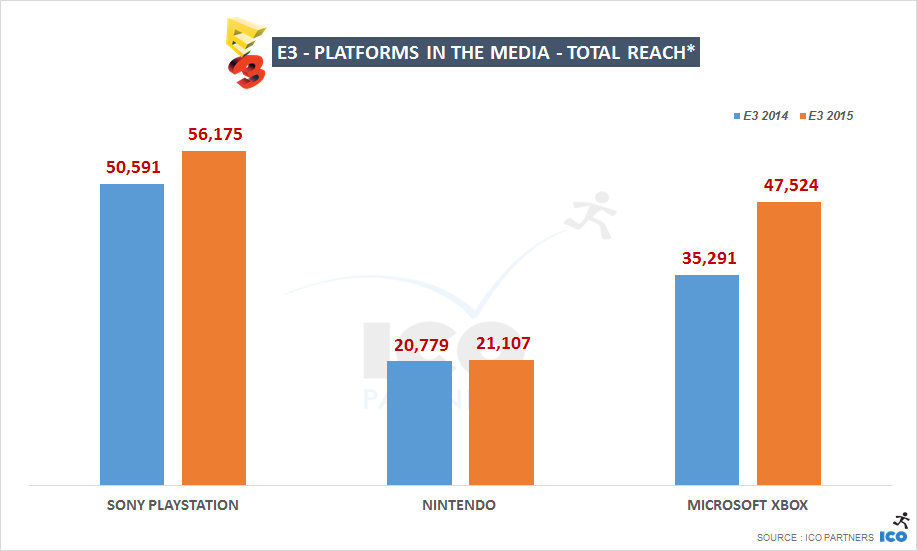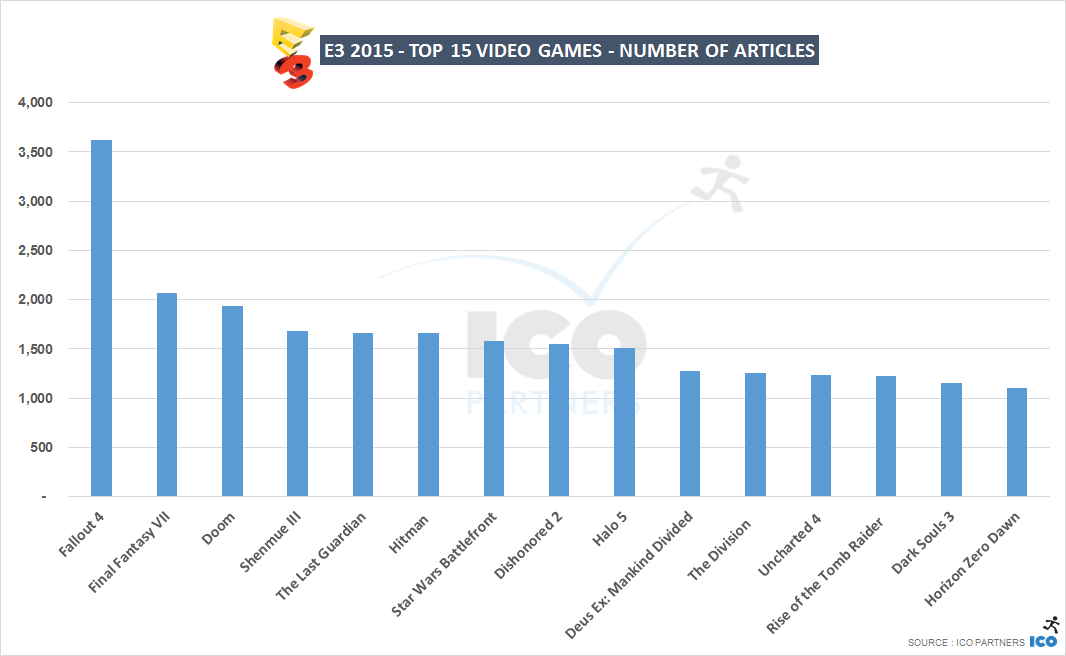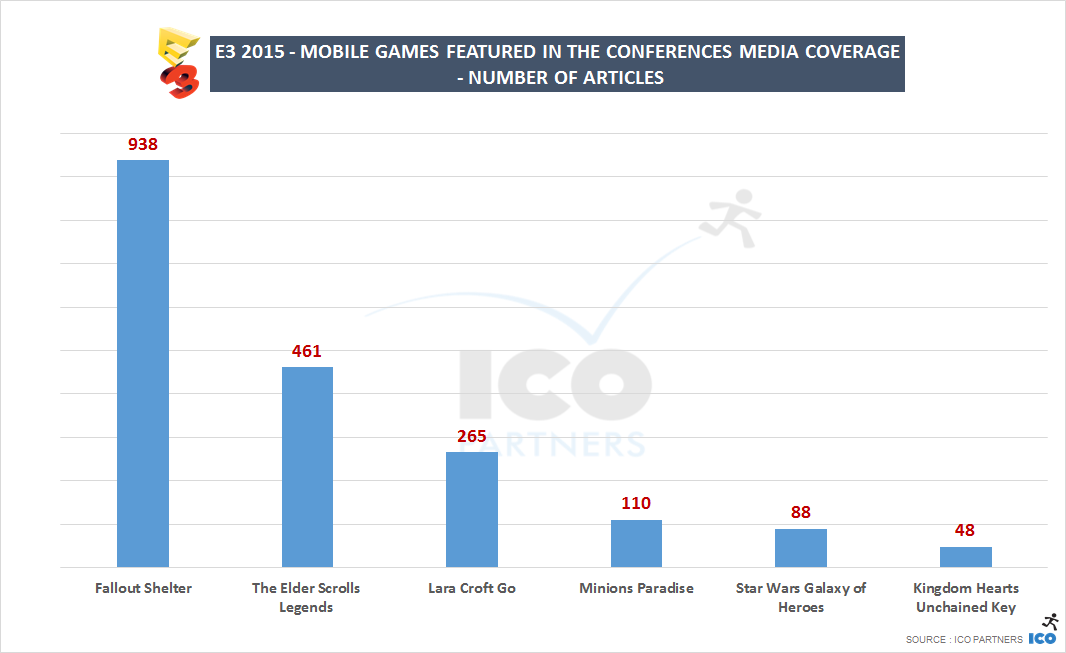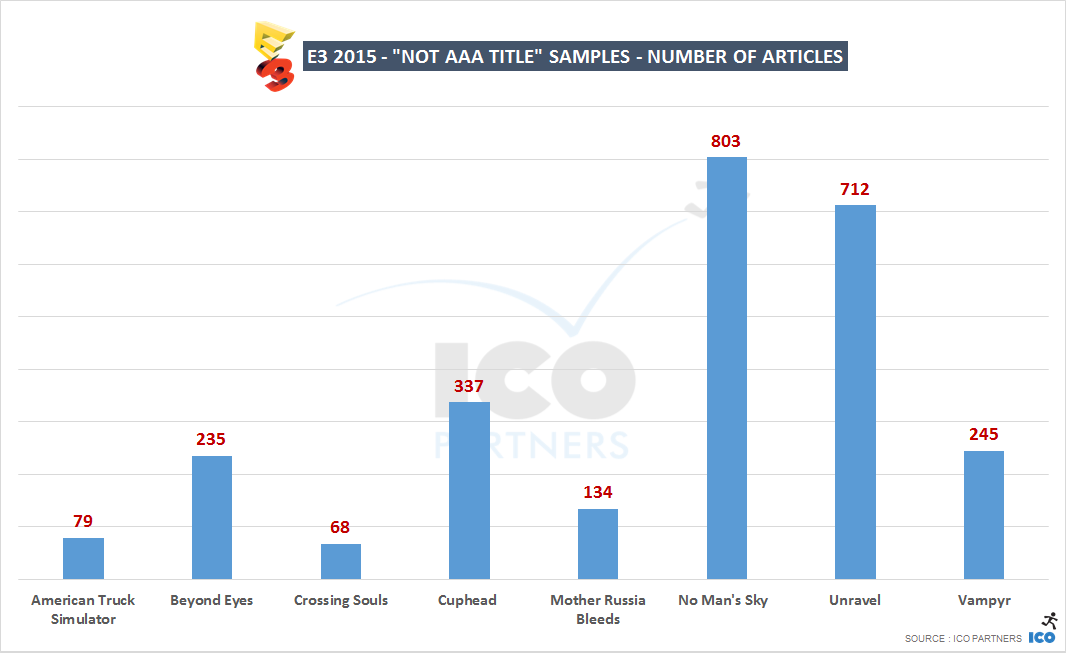[EDIT – the dataset initially used didn’t properly cover the articles published on the 10th of June, making the EA coverage much lower than it should be. I have replaced the following graphs: Top 15 Games; Publishers Conferences Compared; Publishers in the Media]
It’s that time of year again: the week after E3, and time for me to go over the numbers and media coverage from the show, as per tradition. If this the first time for you, please fee free to have a look at the methodology used, and read the blog posts for 2015 and 2016.
Platforms
First, looking at the biggest players at E3, the console manufacturers, in many ways this was an interesting year in light of their performance at previous E3’s.
For the first time since we started measuring media coverage at E3 in 2014, Sony is not leading. It has to be said that the gap between them and Microsoft is very small, but this comes on the back of Microsoft growing for the 4th year in a row, and where Sony had its 3rd best performance out of 4 companies (on the back of its best performance last year).
Nintendo, on the other hand, has had its best E3, doubling the coverage they got last year. The Switch is clearly a commercial success and is also popular with the media. With a smaller lineup than its competitors, it is quite the performance for them. The wider 3rd party program, with Ubisoft’s partnership at the forefront, is likely a significant contribution.
Like last year, I created a Google Spreadsheet to list all the announcements done at E3’s press events – feel free to have a look for your own analysis of the lineup announced for each company:
https://twitter.com/icotom/status/874684542220722176
Personally, here are my thoughts on the 3 manufacturer press events:
- Microsoft. It was their best E3 conference to date, as far as I am concerned. They finally hit the right tone in their announcements. However, nothing they have announced is really pushing the Xbox consoles over their competitors. Not many exclusives that would drive someone to pick an Xbox over anything else. The Xbox One X, if anything, is a console for the convinced customer, the one already in the ecosystem.
- Sony. The conference wasn’t mind-blowing, and the media coverage reflects this, but I think Sony was just playing it safe. There have been enough PlayStation exclusives to come out ahead of the show to allow them to message the console as the better alternative in terms of catalogue. The numerous VR games shown was a great reminder of the PlayStation VR, a strong differentiator when compared to other consoles. My biggest issue with the event was the format. It was hard to understand if the pre-show was meant to be considered as part of the main event – and many of the more interesting projects were revealed there. I will also note that during the show, the dates of this year’s PlayStation Experience were announced. This is a strong message that PSX is becoming the main press event for Sony, and I wouldn’t be surprised if they’ve held back a number of high-profile announcements.
- Nintendo. The numbers are quite telling – this was the best E3 for Nintendo in years. They were coming off of the back of an excellent launch for the Switch, and announced a number of high-profile games that are coming out very soon for the console. In terms of short-term hype, this was brilliantly executed. I am still somewhat confused by the Pokemon and Metroid Prime 4 announcements – they are likely to hype a core fanbase, and have the risk of setting expectations beyond what is being developed. I find announcements of this type are better done with something to show in order to frame what is being put together. But who knows with Nintendo? They may well knock these titles straight out of the ballpark.
Looking at specific platforms, a few things are interesting to highlight:
The Switch got more coverage than the Xbox One X last week – which is impressive considering the higher profile of the Xbox brand. Also impressive: the 3DS is still getting a decent amount of coverage.
The main point to consider, looking at the reach of each console, is the fact that the Xbox brand seems to be very good at getting covered by higher profile media. The short lead the Xbox One has over the PS4 is translated to a more significant lead in reach. And the Xbox One X, being slightly behind in terms of the number of articles compared to the Switch, sees a significant lead when considering the corresponding reach.
Finally, I wanted to check the VR device coverage, to compare it with last years.
Again, PSVR is leading. But, there were about half as many articles as at last E3. That’s a steep decline, most likely due to the fact that the speculation on VR is now in a different phase, with all the devices on the market and being known quantities.
Games
Like the previous year, I looked at the top games based on the volume of media coverage.
Here are a few thoughts coming to me immediately after looking at this list of games:
- [This was what was initially written in the article] EA didn’t do as well as last year. At that time, they had two games that had more than 2,000 articles. This year, Anthem, their best performing game, doesn’t reach that threshold. It’s interesting to note that Anthem is the only newly announced IP on the list.
- [EDIT – Anthem and Star Wars Battlefront 2 show up as two very strong titles in the EA line-up, bringing the total number of games passing the 2,000 articles during E3 week to 3 this year, compared to 5 in 2016. EA keeps 2 titles in that threshold though, a solid, constant performance.]
- Assassin’s Creed Origins is leading for a number of reasons: the game was featured significantly at 2 press events (Microsoft and Ubisoft) on top of being playable at E3.
- Skyrim is marked with an asterisk because it featured in a few different capacities: the Switch Port during the Nintendo conference, the PSVR port during the Sony conference, as well as the fact that the next expansion for Elder Scrolls Legends is featuring Skyrim. This means it’s more difficult than usual to point to this as a game singularly featured.
- With only one game in the 2,000+ articles category for coverage, 2017 is a year with weaker big game announcements than 2016 (which had 5 games in the 2,000+). It says nothing about the quality of the games of course – it is purely a statement of their media coverage.
There were 3 publisher-powered press conferences this year, with Square Enix skipping it again this year. Ubisoft, after three years of growth, is finally coming on top, in large part thanks to the Assassin’s Creed Origins coverage.
[This was what was initially written in the article] EA didn’t seem to manage to secure the right attention. It might be the EA Play formula that didn’t work as well as last year (a single location this time), it might mean the lineup didn’t catch the attention in the same way that last year did. It has to be said that FIFA 18 being a top game for EA this year isn’t actually a good sign, as FIFA 18 didn’t get as much coverage as FIFA 17 had last year. The most disappointing of all is the coverage for Battlefront 2, considering the power of the Star Wars brand and the release this winter of Episode 8.
[EDIT – With the proper dataset, EA’s performance is much more in line with the profile of the company over the past few years, with Star Wars Battlefront II as a top game, and Anthem’s performing very well, in great part due to the double featuring at the EA conference and the Microsoft event]
Bethesda did OK – the two new games obviously getting most of the coverage. But the really strong IPs of the publisher, Elder Scrolls and Fallout, had no revolutionary announcements around them, and in that respect, Bethesda still performed quite well considering.
Finally, Ubisoft’s conference was praised by many attendees and analysts as the best of the show. It had a wide range or projects showcased, an unexpected number of new projects revealed. The lineup was very strong, and then Ubisoft also managed to throw a few curve balls. The fact that they’re going after the declining toys-to-life market with Starlink was totally unexpected, for instance.
Looking into the publishers’ names and how often they were mentioned in the media reinforces the apparent success of Ubisoft:
All 3 companies with a press event did far better than all the others which didn’t. Bethesda and EA both had significantly less coverage than last year though (-25% for EA; -15% for Bethesda). And to nail down Ubisoft’s stellar performance this year, you can look at the progression over the past two years:
Case studies
No short selection of games for this year’s case studies. Instead, I looked at how 2 games’ coverage evolved year-on-year, and how two games from Klei compared to each other a year apart.
After its 4th year being featured at E3, Cuphead is finally going to be released. This illustrates quite nicely how much having a release date helps you coverage-wise. At this point, the game has been covered a lot over the years. The fatigue shows through the numbers at E3 2016, so the 2017 numbers overall indicate a very good performance for a game of that profile.
In its third year at E3, the Dontnod title coverage illustrates a few interesting points:
- Its first year at E3, the game wasn’t featured at any conference, and it had a very decent coverage considering.
- Last year, it was featured during the PC Gaming Show, showing the significant visibility this smaller press conference can still bring you.
- This year is the last one before the game releases. The date has been announced, a feature video was released the previous week (and thus mostly absent in the numbers above), gameplay was at the center of the communication at this E3’s beats. A strong coverage overall, even if not in the range of blockbusters.
These projects by Klei are very interesting to compare: they were both revealed at the PC Gaming Show. It is very difficult to get comparable data over time, but this is quite interesting – two games by the same developer, announced at the same conference at E3.
I haven’t shared data over the PC Gaming Show in the past, and it is mostly because the branding is not as strong and many announcements get relayed without mentioning the event. The fact that a games media outlet is attached to the event as the organizer might play a significant part too. Anyhow, there is evidence of growth in coverage for games featured at this event, and Klei’s games illustrate this quite nicely.
Closing words
I have always felt a bit conflicted about titling these articles “Who won E3?” as there is much more to the data than that. However, this year’s E3 is a bit of an exception. The announcements made, the reaction of the media to them, the progress of the media coverage over the past few years; all of this make me want to declare two, very complementary “winners”.
Nintendo – as they come back into the spotlight and significantly increase their media presence, this has certainly been the best E3 in years for them.
Ubisoft – with their numerous announcements, the way they were orchestrated, and the stellar execution of the Beyond Good and Evil 2 trailer release, all explain how they ended up as the leading publisher of this E3 in terms of coverage.
And I want to think that the two companies’ partnership also played a big role, and is probably not a coincidence considering the position they both have at present in the industry, and their respective challenges.
A few technical notes
Why Nintendo and not the Wii?
In the graphs on consoles over the past 3 years, I am comparing the PlayStation and Xbox brands to Nintendo. The fact is that the other consoles have consistent brands whereas Nintendo machines are using multiple brands. Moreover, Sony and Microsoft are two companies with activities spread across multiple industries and cannot fairly be compared to Nintendo, when we look at articles on games. Nintendo is also a strong publisher, and its brand is more established than one of its consoles, compared to Sony and Microsoft. Comparing platforms to brands is the best way to have comparable results to look at the Nintendo brand, rather than the Wii for instance (or even a combination of the Nintendo consoles).
What is the reach value?
* Like last year, I am referring a few times to the notion of reach. Here is a reminder about it:
The following graph requires some pre-explanation. In order to measure the magnitude of an article, with have created a formula based on the websites’ Alexa ranking to give their articles different “weight”. The more popular the website, the more weight we give to their article. This value is called Reach in our tools and range from 0.1 to 10. For example, currently, Eurogamer.net has a reach of 10, Gamasutra.com has a reach of 8, Road to VR has a reach of 6. So what you see below, is a chart of the total reach of all the articles showed above. We refresh the reach values constantly.

